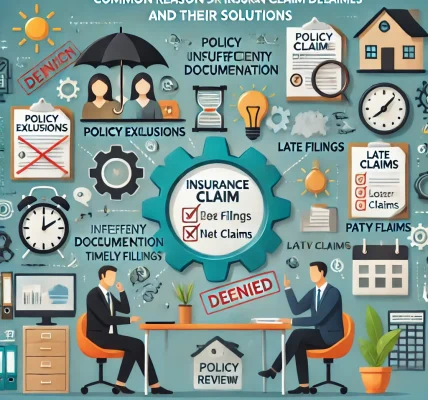Running a business comes with inherent risks, from property damage to liability claims. Business insurance claims play a crucial role in safeguarding your company from unexpected financial losses. This comprehensive DIY guide will walk you through the process of filing and managing business insurance claims effectively.
1. Understanding Business Insurance Claims
A business insurance claim is a formal request made to an insurance company for compensation due to losses covered under a business insurance policy. The types of claims vary depending on the coverage chosen by the business.
Common Types of Business Insurance Claims
- Property Damage Claims (due to fire, storms, vandalism, etc.)
- Business Interruption Claims (for lost income due to covered events)
- General Liability Claims (third-party injury or property damage)
- Workers’ Compensation Claims (employee injuries on the job)
- Cyber Liability Claims (data breaches, hacking incidents)
- Professional Liability Claims (negligence, errors, or omissions in services)
Understanding these claim types helps business owners prepare for potential risks and navigate the claims process smoothly.
2. Step-by-Step Process for Filing a Business Insurance Claim
Step 1: Assess the Situation and Notify Your Insurer
- Identify the type and extent of damage or loss.
- Contact your insurance provider immediately.
- Provide preliminary details such as date, location, and cause of the incident.
Step 2: Document the Damage or Loss
- Take clear photographs and videos of the affected area.
- Gather invoices, purchase receipts, and records of lost business income (for business interruption claims).
- Record witness statements, if applicable.
Step 3: File a Police Report (If Necessary)
- If the claim involves theft, vandalism, or any criminal act, report it to the police.
- Obtain a copy of the police report to support your claim.
Step 4: Complete the Claim Form Accurately
- Fill out the claim form provided by your insurer.
- Attach all necessary documents, including invoices and receipts.
- Provide a detailed explanation of the incident and losses incurred.
Step 5: Cooperate with the Insurance Adjuster
- The insurer may send an adjuster to inspect the damage and verify the claim.
- Be transparent and provide all required documentation to expedite the process.
Step 6: Review and Negotiate the Settlement Offer
- The insurer will offer a settlement based on policy coverage.
- If the offer is insufficient, negotiate with supporting evidence of actual losses.
Step 7: Accept the Settlement and Begin Recovery
- Once satisfied with the claim amount, finalize the process.
- Use the funds to repair, replace, or recover the affected business assets.
3. Common Reasons Business Insurance Claims Get Denied
Insurance claims may be denied for various reasons. Understanding them helps business owners take preventive measures.
Top Reasons for Claim Denial:
- Insufficient Documentation – Lack of proper records, invoices, or receipts.
- Policy Exclusions – The event or loss type is not covered under the policy.
- Delayed Claim Reporting – Failure to notify the insurer within the required timeframe.
- Misrepresentation or Inaccurate Information – Providing false or misleading details.
- Failure to Mitigate Damages – Not taking action to prevent further losses after an incident.
If your claim is denied, you can appeal the decision by submitting additional evidence or negotiating with your insurer.
4. Best Practices for a Smooth Business Insurance Claim Process
To ensure your claim is processed quickly and successfully, follow these best practices:
- Understand Your Policy: Know what is covered and what is not.
- Keep Detailed Records: Maintain financial statements, contracts, and inventory lists.
- Implement Risk Management Measures: Install security systems, fire alarms, and follow safety protocols.
- Work with a Professional: Consider hiring a public adjuster or legal expert for high-value claims.
- Review Your Policy Annually: Update coverage to reflect business growth and new risks.
5. Frequently Asked Questions (FAQs)
Q1: How long does it take to process a business insurance claim?
The timeline varies, but most claims are processed within 30 to 90 days, depending on complexity.
Q2: Can I claim business losses due to a pandemic or government-mandated shutdown?
It depends on your policy. Some business interruption policies exclude pandemics. Always check policy exclusions.
Q3: Should I accept the first settlement offer from my insurer?
Not necessarily. If the amount does not fully cover your losses, negotiate with additional supporting evidence.
Q4: How can I prevent my business insurance claim from being denied?
Ensure timely reporting, maintain accurate records, and understand your policy exclusions.
Q5: Is legal assistance necessary for filing a business insurance claim?
For standard claims, legal help is not required. However, for disputed claims or large settlements, consulting a lawyer or public adjuster is recommended.
Final Thoughts
A well-managed business insurance claim can be the key to recovering from unexpected losses without financial distress. By understanding the claim process, maintaining proper documentation, and proactively managing risks, business owners can protect their assets and ensure financial stability.




